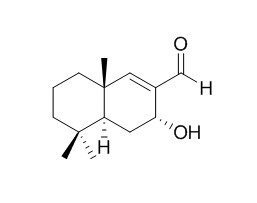Polygonal
Standard reference
Inquire / Order:
manager@chemfaces.com
Technical Inquiries:
service@chemfaces.com
Tel:
+86-27-84237783
Fax:
+86-27-84254680
Address:
1 Building, No. 83, CheCheng Rd., Wuhan Economic and Technological Development Zone, Wuhan, Hubei 430056, PRC
Providing storage is as stated on the product vial and the vial is kept tightly sealed, the product can be stored for up to
24 months(2-8C).
Wherever possible, you should prepare and use solutions on the same day. However, if you need to make up stock solutions in advance, we recommend that you store the solution as aliquots in tightly sealed vials at -20C. Generally, these will be useable for up to two weeks. Before use, and prior to opening the vial we recommend that you allow your product to equilibrate to room temperature for at least 1 hour.
Need more advice on solubility, usage and handling? Please email to: service@chemfaces.com
The packaging of the product may have turned upside down during transportation, resulting in the natural compounds adhering to the neck or cap of the vial. take the vial out of its packaging and gently shake to let the compounds fall to the bottom of the vial. for liquid products, centrifuge at 200-500 RPM to gather the liquid at the bottom of the vial. try to avoid loss or contamination during handling.
SSRN2024, 4937625.
Chem Biol Interact.2018, 283:59-74
Chem Pharm Bull (Tokyo).2017, 65(9):826-832
Horticulture Research2023, uhad164.
Environ Toxicol.2020, doi: 10.1002
Eur J Pharmacol.2022, 917:174744.
Nanjing University of Chinese Medicine2022, 345930.
Vietnam Journal of Food Control.2022, 5(3):pp.488-497.
Phytomedicine.2022, 100:154036.
J Appl Toxicol.2020, 40(7):965-978.
Related and Featured Products
Glob Chang Biol. 2015 Apr;21(4):1634-51.
Polygonal tundra geomorphological change in response to warming alters future CO2 and CH4 flux on the Barrow Peninsula.[Pubmed:
25258295]
The landscape of the Barrow Peninsula in northern Alaska is thought to have formed over centuries to millennia, and is now dominated by ice-wedge Polygonal tundra that spans drained thaw-lake basins and interstitial tundra. In nearby tundra regions, studies have identified a rapid increase in thermokarst formation (i.e., pits) over recent decades in response to climate warming, facilitating changes in Polygonal tundra geomorphology. We assessed the future impact of 100 years of tundra geomorphic change on peak growing season carbon exchange in response to: (i) landscape succession associated with the thaw-lake cycle; and (ii) low, moderate, and extreme scenarios of thermokarst pit formation (10%, 30%, and 50%) reported for Alaskan arctic tundra sites.
METHODS AND RESULTS:
We developed a 30 × 30 m resolution tundra geomorphology map (overall accuracy:75%; Kappa:0.69) for our ~1800 km² study area composed of ten classes; drained slope, high center polygon, flat-center polygon, low center polygon, coalescent low center polygon, polygon trough, meadow, ponds, rivers, and lakes, to determine their spatial distribution across the Barrow Peninsula. Land-atmosphere CO2 and CH4 flux data were collected for the summers of 2006-2010 at eighty-two sites near Barrow, across the mapped classes. The developed geomorphic map was used for the regional assessment of carbon flux. Results indicate (i) at present during peak growing season on the Barrow Peninsula, CO2 uptake occurs at -902.3 10(6) gC-CO2 day(-1) (uncertainty using 95% CI is between -438.3 and -1366 10(6) gC-CO2 day(-1)) and CH4 flux at 28.9 10(6) gC-CH4 day(-1) (uncertainty using 95% CI is between 12.9 and 44.9 10(6) gC-CH4 day(-1)), (ii) one century of future landscape change associated with the thaw-lake cycle only slightly alter CO2 and CH4 exchange, while (iii) moderate increases in thermokarst pits would strengthen both CO2 uptake (-166.9 10(6) gC-CO2 day(-1)) and CH4 flux (2.8 10(6) gC-CH4 day(-1)) with geomorphic change from low to high center polygons, cumulatively resulting in an estimated negative feedback to warming during peak growing season.
Opt Express. 2014 Nov 3;22(22):27476-88.
Polarization dependent enhanced optical transmission through a sub-wavelength polygonal aperture surrounded by polygonal grooves.[Pubmed:
25401895]
METHODS AND RESULTS:
Enhanced optical transmission (EOT) and its polarization extinction ratio (PER) of a sub-wavelength Polygonal aperture surrounded by Polygonal grooves are investigated numerically by finite difference time domain (FDTD) method. Effects of light polarization on EOT were analyzed and compared for four types of geometrical structures: triangle aperture surrounded by triangle grooves, square aperture surrounded by square grooves, rhombus aperture surrounded by rhombus grooves, and pentagon aperture surrounded by pentagon grooves. The effects of relative angles between the symmetry axes of polygons and the light polarization were thoroughly analyzed.
CONCLUSIONS:
Among these plasmonic Polygonal bull's eye structures, the rhombus showed a maximum EOT several times larger than others. In contrast to the prior normal incident condition, we further analyzed the impacts of the incident angle and we found a wideband tunability of EOT wavelengths.



